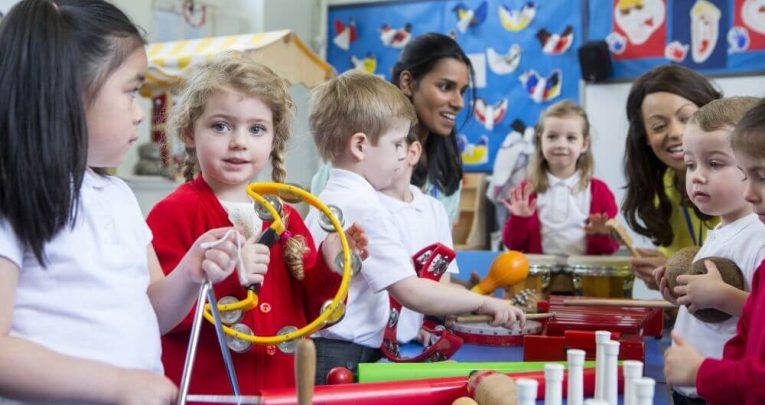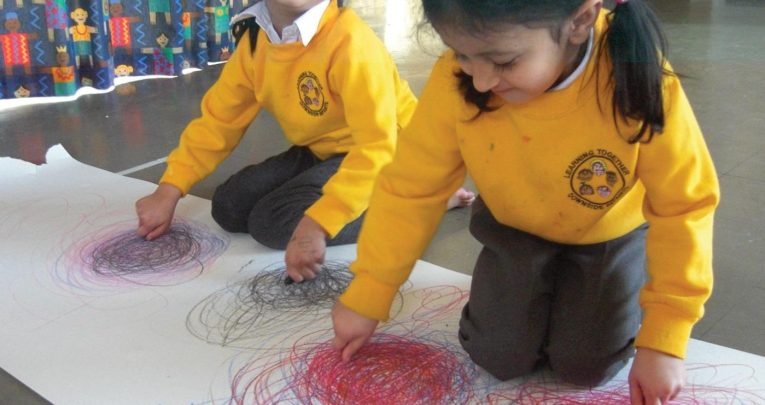Model music curriculum – Let’s seize the opportunity

Join me in making sure that the new Model Music Curriculum has the biggest possible impact on improving music education, says Jimmy Rotheram…

In Monty Python’s masterpiece The Life of Brian, shortly after selling him a packet of otters’ noses, Brian furtively asks John Cleese’s character, “Are you the Judean People’s Front”?
This question elicits a scathing, expletive-ridden response in which Cleese cannot hide his contempt. “Judean People’s Front? We’re the People’s Front of Judea!”
In education, it can be easy to forget that we are all, ultimately, on the same ‘side’ – all of us wanting the best possible education for our children.
We know that what ‘the best’ entails will vary according to individual philosophies and approaches. As a consequence, social media sees many teachers entrenching themselves in various ‘camps’ – ‘knowledge rich’ vs ‘skills based’; traditionalists vs progressives; teacher vs child-led activity; exploration and discovery vs direct instruction.
These debates rage alongside more subject-specific concerns – the ‘Stormzy vs Mozart’ twitter debate saw some advocating for only teaching classical music, up against some teachers who think a focus on Western classical music is elitist and irrelevant to today’s children.
The same arguments apply to traditional notation – for some it is vitally important, for others, it is consciously avoided.
We have also seen divisions within particular, specific niches – every approach will have those wishing to maintain a pure tradition up against the modernisers, and the battle lines are drawn.
If there is one thing we can certainly all agree on unanimously, it’s that there will be disagreement – any music curriculum will have both vehement detractors and enthusiastic supporters. You can please some of the people, some of the time, but we cannot hope to entirely satisfy everyone’s varied expectations. The advisory panel for the Model Music Curriculum was therefore very keen to put forward from day one that it would not be a compulsory, statutory obligation. Rather than being a bible that ‘thou shalt follow’, we were keen for this to be more like a road map to musical literacy.
While it provides a pathway from A to B, we recognised that there are many directions of travel, many different vehicles, and we would not wish to stifle or heavily alter the approach of schools who are already thriving through using a contrasting approach.
The new curriculum, and the freedom to follow alternatives, gives us the opportunity to start to seriously think about curriculum music and how it is delivered, day-to-day.
An opportunity to raise the status of music
No approach is perfect or unanimously agreed upon. There are many things, however, that the vast majority of educators in primary schools will be in agreement with.
One of Nick Gibb’s motivations for providing a model music curriculum was that he was keen to provide a curriculum with more detailed structure, and that “too few pupils are benefitting from a sufficiently rigorous approach.”
This is hard to argue against. In many schools, music has been relegated to the status of an ‘add-on’ – a nice thing to have if we have the time for it, and if it doesn’t get in the way of maths and English, which we are ultimately measured on.
State primaries – like Feversham, where I teach – which take music very seriously, are sadly few and far between. In many schools, music is relegated to 20 minutes of golden time at the end of the school week, once the ‘important’ stuff has been covered.
For many, the previous incarnation of the primary national curriculum was not fit for purpose in providing a clear long-term strategy for delivering music in schools.
The general national curriculum provides 175 pages of guidance for schools on English, maths and science. Music does not feature until page 196, where we see a paltry two pages devoted to what should be six years of musical development.
This sends a clear, if not necessarily deliberate message – maths, English and science are the important subjects. The ‘foundation’ subjects are clearly supplementary and of less importance, relegated to a few vague sentences at the end of the document.
There is very little guidance on what that content might look like or how someone with no training as a music teacher might deliver this in their class (or indeed, how someone with no training or musical experience might organise learning across the whole school as a ‘music coordinator’).
I have written many articles highlighting the considerable benefits of taking music seriously for all children and training the workforce well to deliver it.
The MMC sends a clear message that the government has high expectations for music in primary schools both in terms of progression of skills and the amount of time devoted to the subject, but this needs to be supported by training and empowering class teachers.
Another aspect of the curriculum that music teachers can agree on is that the measure to stipulate a minimum of one hour of music per week in all primary schools is hugely valuable. My hope is that schools will break this down into daily musical activities as well as a longer 30-minute session.
At present, this is incredibly rare, but a ‘little and often’ approach is absolutely vital. We would not teach phonics or maths for 30 minutes once a fortnight – that would be ludicrous, wouldn’t it? The children would never develop confidence and fluency. If music is timetabled infrequently, it is doomed.
Many will also be delighted to see the clear condemnation of the ‘carousel’ approach to musical learning, whereby arts subjects are taught once a fortnight, or only for a term each year. We expect musicians to practise but we don’t give children the opportunity to!
There is a misconception that, rather than enhancing learning, music somehow obstructs success in other subjects. Music helps children achieve in all subjects.
We have the proof of this particular pudding at Feversham in our spectacular journey from a ‘special measures’ school with a narrow, desperate focus on English and maths, to an Ofsted ‘outstanding’ school, in the top 1% of schools in England for pupil progress, all through putting music at the heart of school life.
A catalyst for developing the workforce through collaboration
Another thing that we should all agree on is the problem of an unconfident, under-trained workforce lacking in any substantial music training.
With non-specialist class teachers not only responsible for their class’s musical progression, but often responsible for music across a whole school as music coordinator, the sector is unanimous that the current training provision on ITE courses (usually two to eight hours) is inadequate, and opportunities for further professional development of class teachers have been thin on the ground. According to Zeserson et al (2014):
‘Only 8% of primary teachers in the online survey reported feeling confident about teaching music, 16% were engaged in a professional network for music and 15% had regular opportunities for professional development’.
My big hope is that music hubs, ITE providers and other organisations will be supported in seizing the initiative and ensure that local workforces, and their own staff (often great musicians and instrumental teachers, but perhaps not confident in delivering whole-class curriculum music) are adequately trained in effective primary pedagogy.
While some hubs are already taking this very seriously and offering substantial professional development opportunities, many see their role simple as providing instrumental lessons. This is because supporting curriculum music is not a core role of the hubs, but rather an extension; an add-on to their core priorities.
The new National Plan for Music Education must take this into account and provide the infrastructure and incentive to support staff development. Without this, we are leaving the successful delivery of this, or any other curriculum, to chance. Funding should be used specifically, to empower class teachers to deliver an ambitious curriculum.
There also exist a number of organisations outside of music services who have taken on this mantle – First Thing Music, the British Kodaly Academy, Dalcroze UK, The Voices Foundation, NYCOS and my own work with the Benedetti Foundation. Hopefully, schools will be more motivated to take on this support.
At Feversham, we put five members of staff through certified Kodaly training, meaning we had a highly trained and effective core of staff through the school (they are no longer ‘non-specialists’!) This was all at a cost of 1% of our annual CPD budget – peanuts, in the big scheme of things.
Staff report feeling empowered, far more skilled musically, and are now very confident and accomplished in delivering high-quality music lessons.
The Model Music Curriculum states that “effective delivery is likely to come from schools, teachers, practitioners, professional ensembles, venues, music services and music education hubs working collaboratively.” If this truly happens, it will be a huge step forward for music education and hugely beneficial for the children we teach.
The MMC can be a catalyst for this.
Trending
Diverse repertoire and active listening
Many people feared that this curriculum would only recognise the work of white, Western classical composers, based on a limited view of cultural capital centred on Western values. I hope that these fears have been allayed.
I don’t think I’ve ever seen a more diverse listening curriculum, with Fela Kuti appearing alongside Mozart, Quincy Jones, Zappa and Zeppelin, as well as contemporary BAME composers and female composers from Anne Boyd to Bjork. This represents a commitment to a rich and diverse repertoire.
Active, rather than passive, listening is demanded – all too often music listening is a passive experience with children sitting in still silence or writing about music far too much. Written work may show children’s knowledge of theory and analysis, but tells us nothing of their musical understanding or ability.
The curriculum also states that there should be frequent informal opportunities to perform and pupils should have the opportunity to hear high-quality live performances, either within school or in the wider community.
This is something that Feversham have been doing for years. Our Friday music assemblies are at the heart of our music programme, with children performing alongside professional and amateur adults.
A small budget of £30 per week has seen our school graced with touring Appalachian and Swedish folk artists, musicians from Opera North and the Royal Northern Ballet, local Islamic Nasheed singers and jazz musicians from Leeds College of Music, turning each of our Friday assemblies into spectacular and memorable experiences.
We also feature a lot of local musicians and host community events where music is an integral part.
We will hopefully also see an end to music being seen purely as a way of reinforcing information learned in core subjects. Many music programmes are sacrificed at the altar of cross-curricular work.
However, songs about Vikings are often not necessarily particularly effective in helping children recall knowledge and information about Vikings, and musical learning is limited too. Far better to do a clapping game to develop speech and language (see the research of Katie Overy and others).
Music is already more cross-curricular than you might first think.
Use of age-appropriate materials
Many songs aimed at children are not written with sufficient consideration of child development. This is most apparent in nursery rhymes, which often feature complex melodies and huge ranges which many younger children are physically incapable of singing.
The MMC recognises that a smaller range is required for younger children. An obstacle to all children singing successfully is presenting songs outside of a comfortable singing range.
A renewed focus on creativity and improvisation
A criticism often levelled at previous incarnations of the national curriculum is that creativity was sorely neglected. In the Primary MMC, importance is placed on the power of improvisation to develop musicianship and generate compositional processes, including using pictures as compositional prompts.
Is notation appropriate for primary school children? Are they ready for it? This is a debate raging in music education. For me the answer is yes – they are ready for it as early as Y1, but only if taught in a child-friendly way with plenty of preparation, scaffolding and careful sequencing.
If it’s done in a dull, abstract manner (as it so often is), or relies on mnemonics and note-naming rather than a deep, embedded internalisation of pitch relations, it will be ineffective and switch children off from the pleasures of holistic musical literacy.
The ‘graphic score’ stipulation allows for traditional notation development alongside simplified ‘stick’ notation and other alternatives, and there is a clear ‘sound before symbol’ methodology common to most effective approaches.
However, flexibility of delivery means that a Kodaly teacher can use hand signs to reinforce pitch, whereas a Dalcroze teacher would want movement to drive the learning.
Understanding pitch starts with two notes (high and low) before developing into three notes (higher, middle, lower) and eventually building up to the pentatonic scale, which provides the foundations of so much music. This prepares children for classical music but also singing blues and jazz, traditional music from around the world and popular music.
To see how this might be effectively brought to life, please take a look at a video I made for the BBC. Starting with the preparation stage where children learn concepts unconsciously through singing and playing musical games, we see progression as the children learn musical sounds before finally being taught the ‘factual knowledge’ of notation and musical symbols.
Our social responsibility
In poorer areas like Bradford Moor where Feversham is located, for many complex reasons parents are unable to support children with learning music at home.
If it doesn’t happen for these children in school, we are not merely leaving it to chance – we are denying children the same opportunities and arts-rich education that their wealthier peers in private education may take for granted. We are also denying a sense of community and belonging.
The schools minister has spoken of his wonderful music education in his private school and his desire for all children to be given the same opportunities. According to a Musicians’ Union report, families earning less than £28k per year are highly unlikely to take up a musical instrument.
If it does not happen in school, it will not happen at all for these children.
The creative arts industry is our third biggest, bringing in billions to the treasury, and yet our state school system does little to provide children with the opportunity to be part of this pipeline.
44% of people working in the Creative Arts sector were privately educated, thanks to their increased opportunities for development. Whether we deny this completely to children from ordinary backgrounds is still our choice, but I wouldn’t want that on my conscience.
An exciting opportunity
While some may disagree with the details and specific content, the ambition of this curriculum is undeniable, and it represents an exciting opportunity to significantly overhaul our music education system.
Although the curriculum is only one part of the puzzle, it is a significant part. My hope is that the MMC can act as a driver to improve opportunities for all children to have a truly broad and balanced, arts-rich education, with substantial support for schools provided by music hubs and other providers of CPD.
It starts with taking music education – for all children, not just those who appear ‘gifted’ – very seriously, and I hope the MMC can be a catalyst for change for this much neglected and declining subject. The mental wellbeing, and academic development of all children is dependent on it, as is our changing economic landscape. As Kodaly states:
‘Real art is one of the most powerful forces in the rise of mankind, and he who renders it accessible to as many people as possible is a benefactor of humanity.’
This is a chance to be benefactors of humanity – to make the world a better place through promoting music education for all children. I hope you will all join me in making sure that this new curriculum has the biggest possible impact on improving music education, whether you agree with the content or not.
Let us have the debates and the discussions. Let’s find new ways forward together, as a profession. Let’s work out what is working in music education and what isn’t, and let’s make music education matter.
Jimmy Rotheram is a music teacher at Feversham Primary, Bradford and a member of the expert panel for the Model Music Curriculum. Follow him on Twitter at @musicedu4all.











